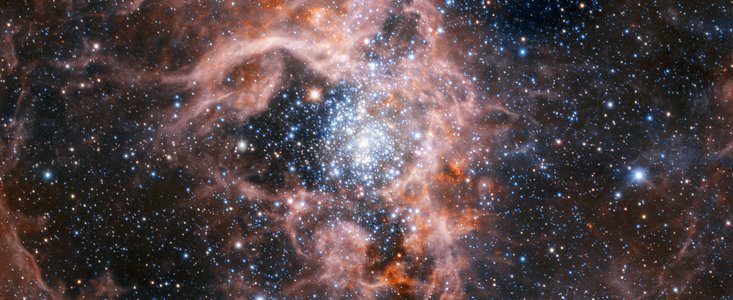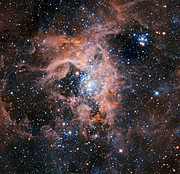Annonce
Sharper Images for VLT Infrared Camera
Adaptive optics facility extended to HAWK-I instrument
30 janvier 2018
ESO’s Very Large Telescope (VLT) now has a second instrument working with the powerful Adaptive Optics Facility (AOF). The infrared instrument HAWK-I (High Acuity Wide-field K-band Imager) [1] is now also benefiting from sharper images and shorter exposure times. This follows the successful integration of the AOF with MUSE (the Multi Unit Spectroscopic Explorer).
The Adaptive Optics Facility (AOF) is a long-term project that is nearing completion on ESO’s Very Large Telescope (VLT). It provides adaptive optics correction for all the instruments attached to one of the VLT Unit Telescopes (UT4, also known as Yepun).
Adaptive optics works to compensate for the blurring effect of the Earth’s atmosphere. This upgrade now enables HAWK-I to obtain sharper images, needing shorter exposure times than before to obtain similar results. By using the AOF, astronomers can now get good image quality with HAWK-I, even when the weather conditions are not perfect.
Following a series of tests of the new system, the commissioning team of astronomers and engineers were rewarded with a series of spectacular images, including one of the Tarantula Nebula star-forming region in the Large Magellanic Cloud.
The AOF, which made these observations possible, is composed of many parts working together. These include the Four Laser Guide Star Facility (4LGSF) and the UT4’s very thin deformable secondary mirror, which is able to change its shape [2] [3]. The 4LGSF shines four 22-watt laser beams into the sky to make sodium atoms in the upper atmosphere glow as bright points of light, forming artificial guide stars.
Sensors in the adaptive optics module GRAAL (GRound layer Adaptive optics Assisted by Lasers) use these artificial guide stars to determine the atmospheric conditions. One thousand times per second, the AOF system calculates the correction that must be applied to the telescope’s deformable secondary mirror to compensate for the atmospheric disturbance.
GRAAL corrects for the turbulence in the layer of atmosphere up to about 500 metres above the telescope — the “ground layer”. Depending on the conditions, atmospheric turbulence occurs at all altitudes, but studies have shown that the largest fraction of the disturbance occurs in the ground layer of the atmosphere.
The corrections applied by the AOF rapidly and continuously improve the image quality by concentrating the light to form sharper images, allowing HAWK-I to resolve finer details and detect fainter stars than previously possible.
MUSE and HAWK-I are not the only instruments that will benefit from the AOF; in future, the new instrument ERIS will be installed on the VLT. The AOF is also a pathfinder for adaptive optics on ESO’s Extremely Large Telescope (ELT).
Notes
[1] HAWK-I is a wide-field imager, an instrument that takes images of the sky in infrared wavelengths. This allows it to see inside interstellar dust and gas, which blocks optical light. The instrument uses four imaging chips simultaneously to achieve such a large field of view, capturing a wealth of information.
[2] At just over one metre in diameter, this is the largest adaptive optics mirror in operation and demanded cutting-edge technology to make it. It was mounted on UT4 in 2016 (ann16078) to replace the telescope’s original conventional secondary mirror.
[3] Other tools to optimise the operation of the AOF have been developed and are now operational. These include an extension of the Astronomical Site Monitor software that monitors the atmosphere to determine the altitude at which the turbulence is occurring, and the Laser Traffic Control System (LTCS) that prevents other telescopes looking into the laser beams or spots and potentially affecting their observations.
Liens
- GRAAL and the VLT deformable secondary mirror technical information
- Event to mark the first light of the 4 Laser Guide Star Facility on the VLT
- The HAWK-I camera
Contacts
Harald Kuntschner
ESO, AOF Project Scientist
Garching bei München, Germany
Tel: +49 89 3200 6465
Email: hkuntsch@eso.org
Richard Hook
ESO Public Information Officer
Garching bei München, Germany
Tel: +49 89 3200 6655
Cell: +49 151 1537 3591
Email: rhook@eso.org
À propos de l'annonce
| Identification: | ann18006 |
Our use of Cookies
We use cookies that are essential for accessing our websites and using our services. We also use cookies to analyse, measure and improve our websites’ performance, to enable content sharing via social media and to display media content hosted on third-party platforms.
ESO Cookies Policy
The European Organisation for Astronomical Research in the Southern Hemisphere (ESO) is the pre-eminent intergovernmental science and technology organisation in astronomy. It carries out an ambitious programme focused on the design, construction and operation of powerful ground-based observing facilities for astronomy.
This Cookies Policy is intended to provide clarity by outlining the cookies used on the ESO public websites, their functions, the options you have for controlling them, and the ways you can contact us for additional details.
What are cookies?
Cookies are small pieces of data stored on your device by websites you visit. They serve various purposes, such as remembering login credentials and preferences and enhance your browsing experience.
Categories of cookies we use
Essential cookies (always active): These cookies are strictly necessary for the proper functioning of our website. Without these cookies, the website cannot operate correctly, and certain services, such as logging in or accessing secure areas, may not be available; because they are essential for the website’s operation, they cannot be disabled.
Functional Cookies: These cookies enhance your browsing experience by enabling additional features and personalization, such as remembering your preferences and settings. While not strictly necessary for the website to function, they improve usability and convenience; these cookies are only placed if you provide your consent.
Analytics cookies: These cookies collect information about how visitors interact with our website, such as which pages are visited most often and how users navigate the site. This data helps us improve website performance, optimize content, and enhance the user experience; these cookies are only placed if you provide your consent. We use the following analytics cookies.
Matomo Cookies:
This website uses Matomo (formerly Piwik), an open source software which enables the statistical analysis of website visits. Matomo uses cookies (text files) which are saved on your computer and which allow us to analyze how you use our website. The website user information generated by the cookies will only be saved on the servers of our IT Department. We use this information to analyze www.eso.org visits and to prepare reports on website activities. These data will not be disclosed to third parties.
On behalf of ESO, Matomo will use this information for the purpose of evaluating your use of the website, compiling reports on website activity and providing other services relating to website activity and internet usage.
Matomo cookies settings:
Additional Third-party cookies on ESO websites: some of our pages display content from external providers, e.g. YouTube.
Such third-party services are outside of ESO control and may, at any time, change their terms of service, use of cookies, etc.
YouTube: Some videos on the ESO website are embedded from ESO’s official YouTube channel. We have enabled YouTube’s privacy-enhanced mode, meaning that no cookies are set unless the user actively clicks on the video to play it. Additionally, in this mode, YouTube does not store any personally identifiable cookie data for embedded video playbacks. For more details, please refer to YouTube’s embedding videos information page.
Cookies can also be classified based on the following elements.
Regarding the domain, there are:
- First-party cookies, set by the website you are currently visiting. They are stored by the same domain that you are browsing and are used to enhance your experience on that site;
- Third-party cookies, set by a domain other than the one you are currently visiting.
As for their duration, cookies can be:
- Browser-session cookies, which are deleted when the user closes the browser;
- Stored cookies, which stay on the user's device for a predetermined period of time.
How to manage cookies
Cookie settings: You can modify your cookie choices for the ESO webpages at any time by clicking on the link Cookie settings at the bottom of any page.
In your browser: If you wish to delete cookies or instruct your browser to delete or block cookies by default, please visit the help pages of your browser:
Please be aware that if you delete or decline cookies, certain functionalities of our website may be not be available and your browsing experience may be affected.
You can set most browsers to prevent any cookies being placed on your device, but you may then have to manually adjust some preferences every time you visit a site/page. And some services and functionalities may not work properly at all (e.g. profile logging-in, shop check out).
Updates to the ESO Cookies Policy
The ESO Cookies Policy may be subject to future updates, which will be made available on this page.
Additional information
For any queries related to cookies, please contact: pdprATesoDOTorg.
As ESO public webpages are managed by our Department of Communication, your questions will be dealt with the support of the said Department.



